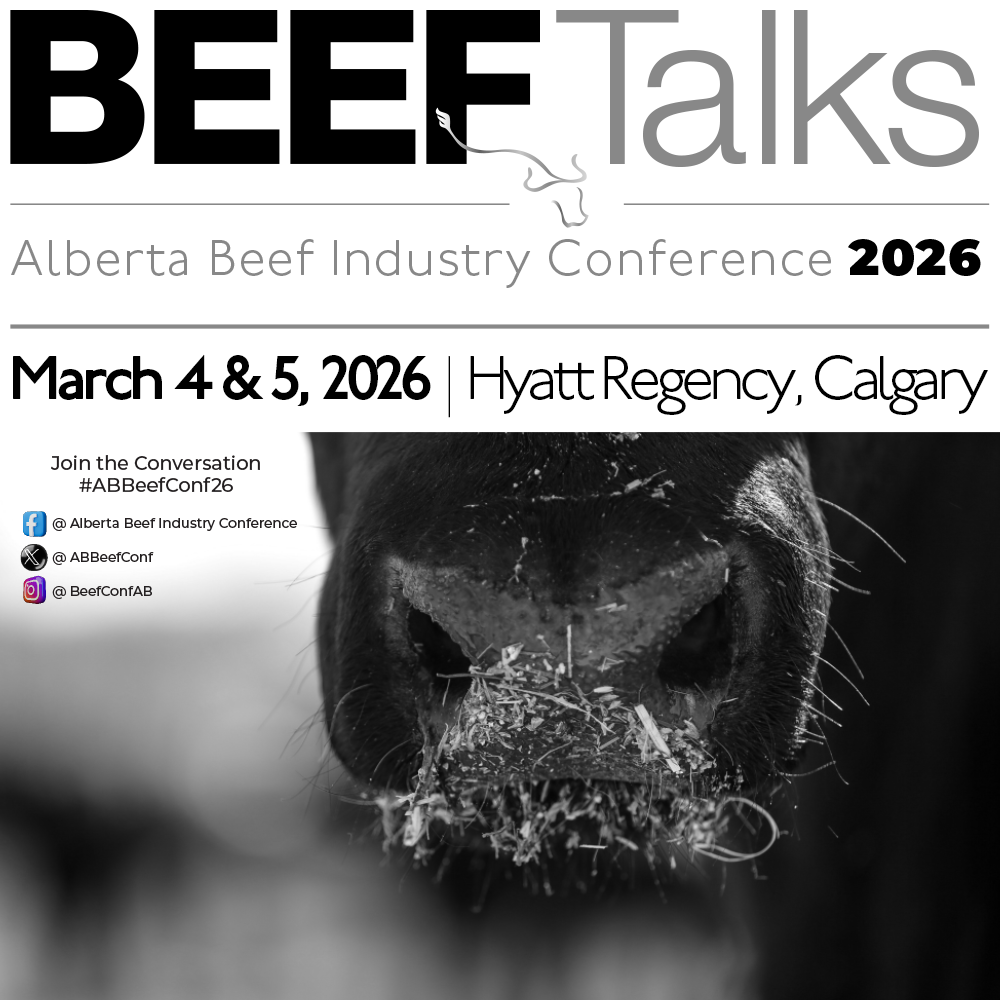AB Direct - Steers
Rail: 490.50-493.00 FOB feedlot (last week)
AB Direct - Heifers
Rail: 490.50-493.00 FOB feedlot (last week)
US Trade- Steers
Rail: 353.00-355.00 (IA, NE) last week
US Trade - Heifers
Rail: 353.00-355.00 (IA, NE) last week
Canadian Dollar
0.01

What you need to know about bovine tuberculosis investigations
In late November 2024, a six-year-old cow infected with bovine tuberculosis (bTB) was detected at slaughter. This animal was traced back to a premise in Saskatchewan, where more positive animals were detected. As part of rigorous eradication protocols, a thorough disease investigation must occur to maintain Canada’s current international trade opportunities. Updates on the current investigation can be found online via the CFIA.
As part of this investigation, producers may be contacted by the CFIA.
This post provides an overview of what to expect if you are contacted as part of a bTB investigation, including details on testing procedures, compensation, information on what happens if an animal on your operation is identified as infected, and additional actions you can take if your operation becomes part of a bTB investigation.
On this page:
What is bovine tuberculosis (bTB)?
Bovine tuberculosis (bTB) is a contagious, chronic disease caused by the bacterium Mycobacterium bovis. It is a slow, progressive disease that can also be dormant or latent in an infected animal for months or years before becoming “active.” Characteristic lesions called granulomas in lymph nodes and other tissues are formed by the body trying to “wall off” the disease.
Few infections in Canada progress to the point of clinical symptoms, but if present, animals may become weak, have reduced feed intake, weight loss, a fluctuating fever, or a cough (if the disease is present in the lungs).
The bacteria are shed and spread through respiratory secretions and aerosols, feces, and milk. They can also be found in urine, vaginal secretions, or semen. Bovine TB is most likely to spread with repeated and frequent contact over a more extended period (weeks or months versus days).
Intermittent shedding may occur even when the disease is in the dormant or latent phase.
The bacteria are sensitive to heat and sunlight but may persist in the environment for several months under darker, cooler, and moister conditions.
While it is primarily found in cattle, bTB can infect other mammals, including deer, bison, goats, pigs, cats, and dogs. It can also be transmitted to humans, however; cases are rare and usually limited to those with prolonged and direct close contact with an infected animal.
A known wildlife reservoir of bTB exists in Wood Buffalo National Park. In every bTB investigation, wildlife surveillance (primarily ungulates) is undertaken to rule out wildlife as a source, or to make sure the disease hasn’t spilled over to wildlife.
Bovine TB is a reportable disease in Canada and has been subject to an eradication program since 1923. While all areas of Canada are considered officially free of bTB today, the insidious nature of the disease can result in occasional isolated cases, which are typically detected during slaughter surveillance.
How could an operation become involved in an investigation?
There are five main categories of herds that CFIA will investigate. Each category represents a potential method for disease spread to other animals. These categories do not necessarily carry the same risk level in terms of disease spread, and there may be differences amongst categories in testing or other disease control procedures.
*Please note that each individual premise undergoes its own assessment. Based on this assessment, there may be differences in disease control procedures.*
- Lifeline herds: These are herds directly linked to a positive animal from the infected herd
- Trace out herds: These are herds that contain animals from the infected herd
- Trace in herds: These are herds that provided animals to the infected herd
- Contact herds: These are herds that either commingled with the infected herd or shared fencelines
- Proximity herds: These herds are located in a 5 km radius of an infected herd. The proximity investigation examines potential spread to or from herds not identified through other means.
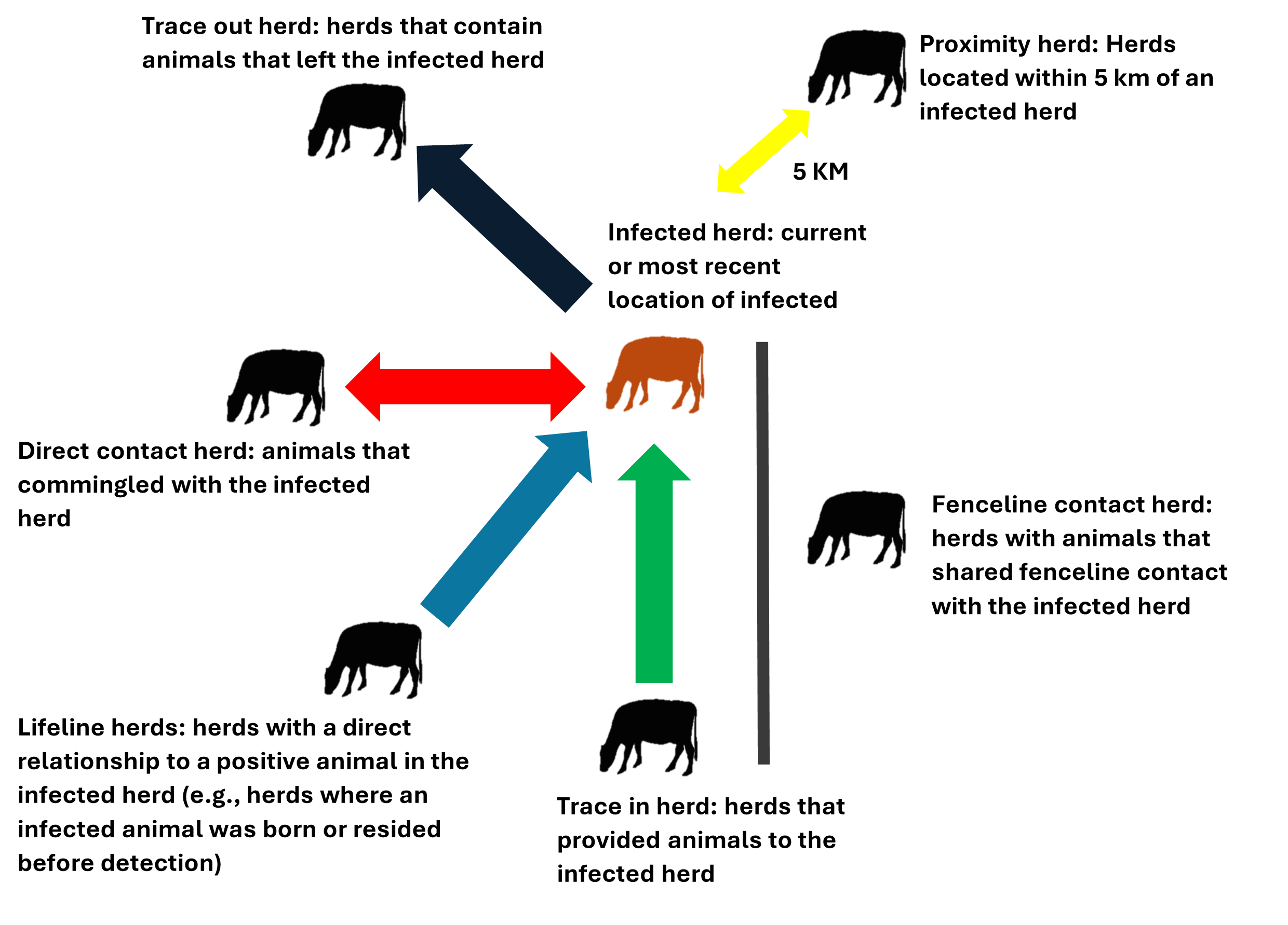
If your herd falls into any of these categories, you will be contacted by CFIA. Click here for more information.
What happens if CFIA contacts me?
If CFIA contacts you as part of a bTB investigation, CFIA staff will work with you to gather information about your herd and management system through a premise investigation questionnaire (PIQ).
Information you will need to gather includes (but may not be limited to):
- A site plan of the operation (including non-contiguous lands) and any associated premise identification numbers (PID). Visit https://animalhealth.ca/site-map/ to learn more about creating a site map.
- Canadian Cattle Identification Agency (CCIA) or Canadian Livestock Tracking System (CLTS) account number.
- Number and type of animals on the premise (e.g., 100 cows, 50 backgrounders, 25 bred heifers, 4 bulls, etc.).
- Other species of livestock on the premise.
- Any recent signs of illness, unexplained mortalities, decreased productivity, veterinary reports, or laboratory testing reports.
- Animal movement records over at least the past 5 years (all animals that entered or left the operation, including custom grazing or calving, direct/private and auction market sales, or animals sent directly slaughter). Records may be required for a longer period of time based on the information gathered during the investigation. Ideally these records are kept on an individual animal basis.
- Records of animals that died on-farm along with any associated symptoms or diagnoses.
- Management information such as how certain groups of cattle interact with each other through your production cycle – this is to determine which animals may have potentially been exposed to the disease. This includes:
- grazing management,
- winter feeding practices,
- backgrounding or finishing activites,
- any commingling with cattle owned by other producers (even fence jumpers),
- fenceline contact with other cattle or livestock species, and
- the presence or absence of wildlife that may have had opportunity to interact with cattle.
- Your veterinarian’s contact information.
- Records of recent purchases or sales to inform compensation for animals ordered destroyed.
It is also a good idea to keep a visitor logbook with the date, visitor, and reason for visit recorded at the minimum. Additional information that could be very beneficial in a disease investigation would be any biosecurity protocols that were followed, and the last animal contact visitors had prior.
What happens after all the requested information is provided?
- If disease control actions are required based on the information provided to CFIA, you will be informed of next steps.
- If trace out animals are still present in your herd, they will be ordered destroyed, with compensation (see compensation section below).
- Further herd testing may also be required.
- You will also be assigned a CFIA case officer to work directly with you and answer your questions.
How does testing work?
- It is important to note that the primary diagnostic tests for bTB are not 100% accurate.
- The most common test is called a caudal fold test (CFT). A small amount of tuberculin is injected into the caudal fold of the tail and the injection site is examined three days later. If there is a raised bump, this is called a reactor. A 1-5% reactor rate is expected even in herds that are not infected with bTB due to cross reactions that can occur with other mycobacteria.
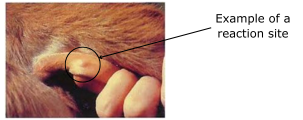
- At the same time, a blood sample may be drawn for an interferon gamma (Bovigam) test.
- Different tests may be used at the same time (in parallel) in higher risk herds to reduce the number of false negatives. This means that reactors from either test would be ordered destroyed, with compensation.
- If tests are used on lower risk herds in series to reduce the number of false positives, this means that only reactors to both tests would be ordered destroyed, with compensation.
- Animals may react to the CFT test and not Bovigam or vice versa. A comparative cervical test (CCT) may also be used in some limited and specific circumstances. The CCT is like the CFT test but also uses avian tuberculin and is administered in the neck.
- Reactors ordered destroyed will be sent for an enhanced postmortem examination to look for lesions or granulomas consistent with bTB infection.
- Samples are collected and sent to the lab for histopathology, regardless of whether lesions are found.
- A positive histopathology result does not necessarily mean the animal is infected, as there are other diseases (i.e. avian tuberculosis, Johne’s) that look like bTB. Similarly, a negative histopathology result does not necessarily mean the animal is disease free.
- A DNA test (PCR) may not be used in all situations but would be used to confirm infection on a new premise.
- Samples are also cultured to see if the bTB bacteria are present. If culture is negative, only then is an animal considered to be uninfected.
- Either PCR or culture can confirm infection, but culture is required for specific strain identification.
- After post-mortem tissue samples are received and processed by the lab, test results are available after approximately 2 weeks, except for culture results which require up to 12-16 weeks.
Testing by herd classification
- Live animal testing considers herd size, epidemiological data, and testing team capacity to deliver different testing methods.
- Testing involves both live animal and laboratory testing. The full testing process can take up to 12-16 weeks.
- Some situations may require a second herd test to confirm non-infection. If this is the case, producers will be notified before testing begins. The second herd test normally takes place six to 12 months after the first test.
- All samples from enhanced postmortem, or samples from regular postmortem that have lesions consistent with bTB, will be sent for histopathology and culture.
- If histopathology looks consistent with bTB, PCR may be used to confirm.
- If negative histopathology results are received, a risk assessment will be performed. Herds may be eligible for early release from quarantine before final culture results are received, but this will be determined on a case-by-case basis. If a herd receives early release, producers are required to keep detailed animal records until final culture results are available.
- More information is available from the CFIA.
Infected herds
- A herd is declared infected if an infected animal is traced to a herd where it very recently resided, or herd testing confirms an infected animal.
- Histopathology and culture are required for all reactors and any non-reactors found upon slaughter with lesions that look like bTB.
- A positive PCR or culture confirms an infected animal.

Lifeline herds
These are herds with a direct relationship to a positive animal in the infected herd (e.g., herds where an infected animal was born or resided before detection). If a purchased animal is identified as infected, this animal is traced back to every herd where it resided since birth – those herds are lifeline herds.

Contact herds
Contact herds are those that have comingled with an infected animal/herd or shared a fenceline. There are different risk levels of contact herds.
- High risk contact herds have had repeated exposure to an infected animal/herd over a significant period of time (e.g., shared summer grazing or winter feeding, etc.)
- Moderate risk contact herds have had contact with an infected animal/herd for a limited period of time (e.g., shorter duration commingling (weeks or a couple of months), shared equipment or water sources with an infected animal/herd, fenceline contact during most of the year, etc.)
- Low risk contact herds have had shorter periods of commingling or fenceline contact (i.e. days versus weeks or months).
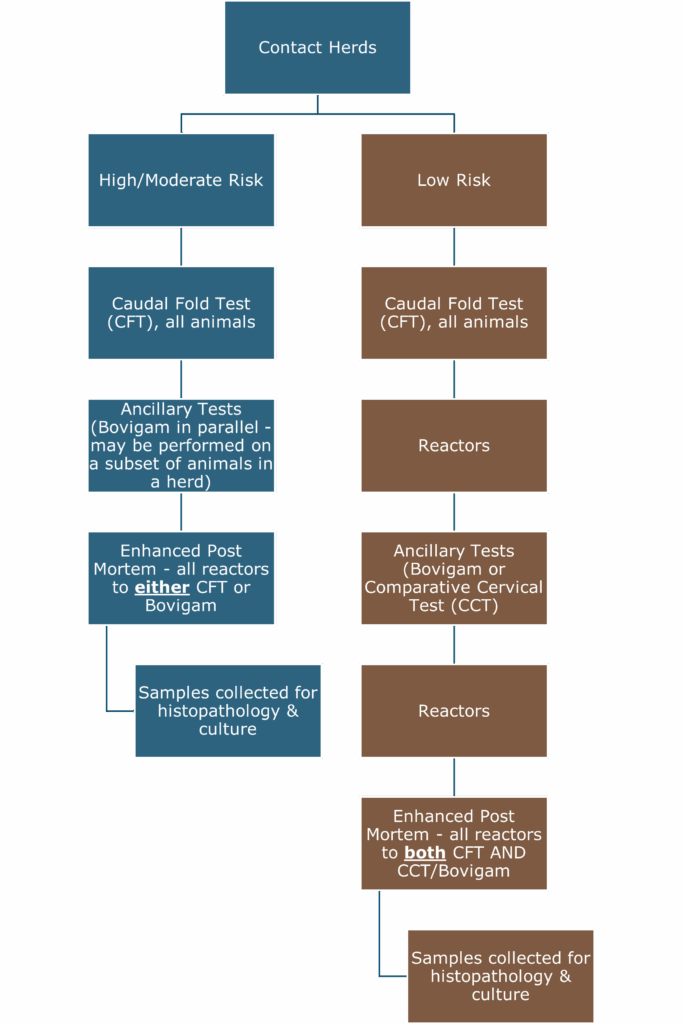
Trace Out Herds
- If a trace out animal is traced to a herd but cannot be located (no evidence it has left the herd, or it cannot be identified), a second herd test may be performed six to 12 months after the first test.
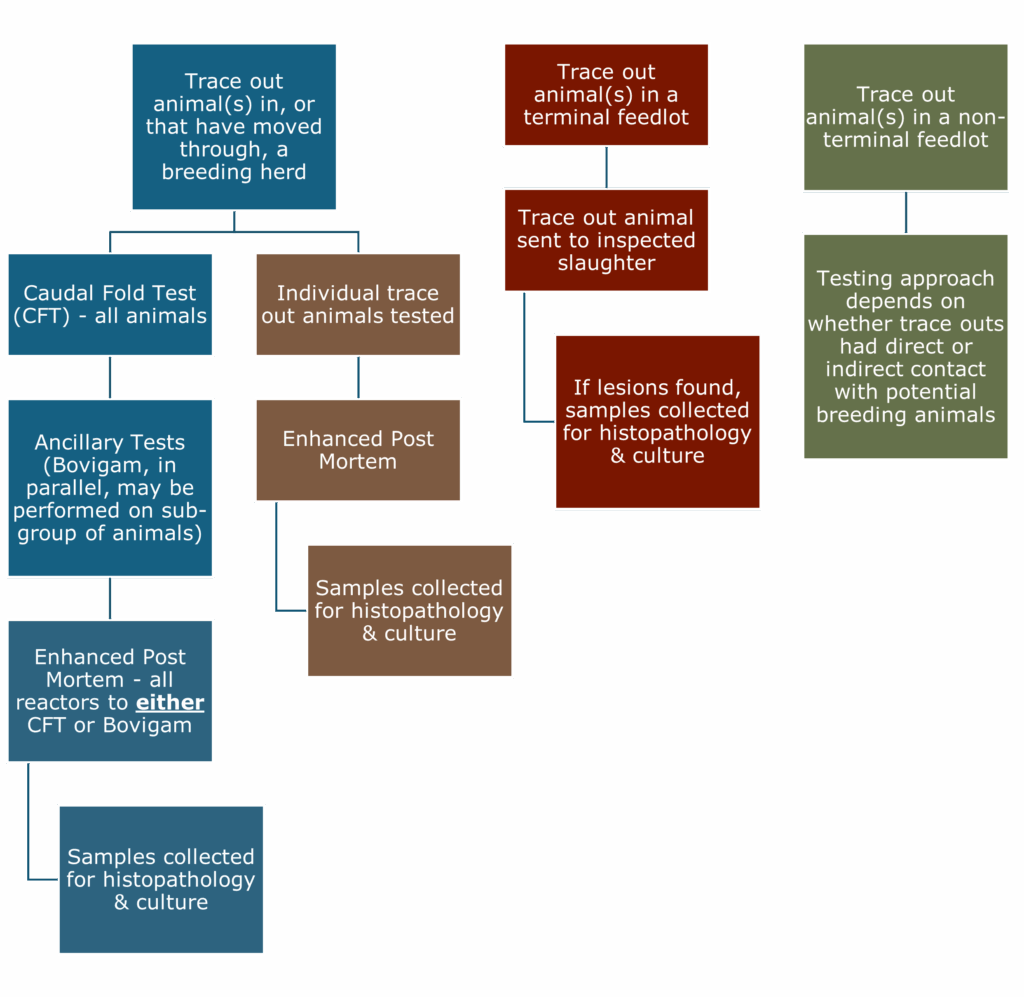
Trace In Herds
Trace in herds are those that provided animals to the infected herd.
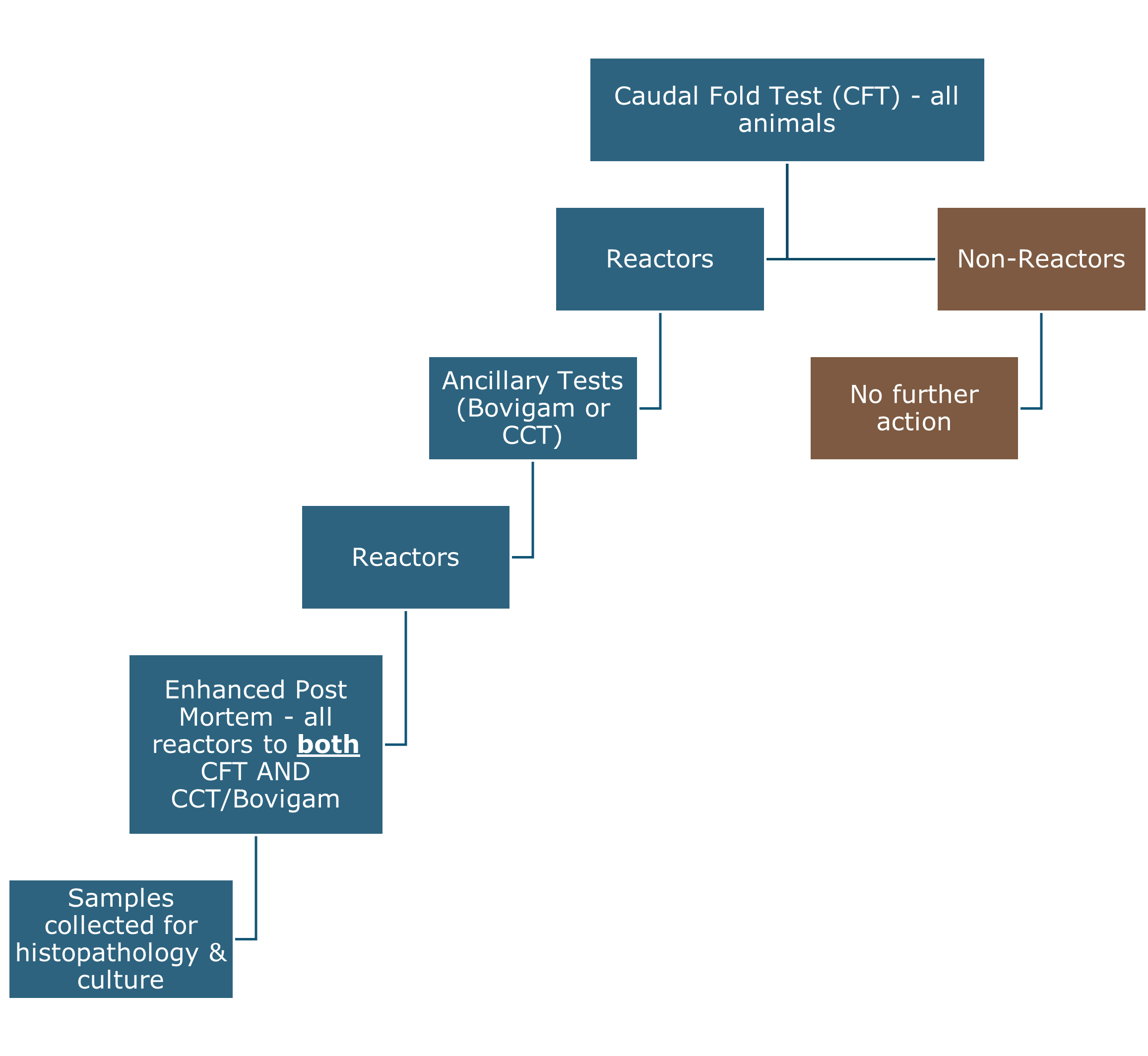
Proximity Herds
- Herds located within 5 km of an infected premise will be tested. Exact methods are determined based on a risk assessment and the species involved.
Other Testing
- In conjunction with the province, CFIA will develop a wildlife surveillance plan for the area around an infected premise. This surveillance is generally undertaken alongside chronic wasting disease surveillance and relies on hunter derived samples. The surveillance plan is usually designed to detect a 1% prevalence of the disease in the estimated wildlife population at a confidence level of 95%.
What if animals are ordered to be destroyed? How does compensation work?
- CFIA provides compensation for animals (or objects) ordered destroyed or disposed and will assist in making arrangements for slaughter.
- Compensation for animals is based on current market conditions and producer records of recent sales for the specific type of animal (bred heifer, bred cow, cull cow, feeder steers/heifers, unweaned calves, etc.) in a disease-free market as of the date that animal was ordered destroyed. For example, a pregnant cow ordered destroyed would be assessed according to her value, but the potential future value of the unborn calf would not be included.
- The current maximum compensation amounts are $10,000 for a non-registered (commercial) animal and $16,500 for a registered (purebred) animal.
- If the animal is salvageable for slaughter this amount is deducted from the compensation CFIA pays.
Example Scenario
A bred heifer is ordered to be destroyed due to a bovine tuberculosis investigation. The compensation amount for the heifer is determined to be $6,500. When the heifer is sent to the slaughter plant, the carcass value is assessed at $2,500. Consequently, the producer receives $2,500 from the slaughter plant. Additionally, the Canadian Food Inspection Agency (CFIA) provides a separate payment of $4,000 to the producer. In total, the producer receives $6,500 in compensation for the heifer.
- Compensation values can be appealed within three months of receiving the compensation form (Notice to Dispose and Award of Compensation form 4203).
- CFIA does not compensate for additional costs associated with quarantines (such as extra feed), opportunity costs for lost marketing opportunities, or costs related to cleaning and disinfection (if required). Additional business risk management programming through lenders, provincial governments, or Agriculture and Agri-Food Canada must be accessed or activated to cover these costs.
- More information on compensation is available via CFIA.
What if testing identifies an infected animal on my operation?
- If an infected animal is confirmed, a quarantine will be immediately placed on your operation. This means any movements of animals or animal-related products must be approved by CFIA prior to the movement taking place.
- The entire herd will be tested and then humanely depopulated, generally through existing processing plants, with compensation.
- Reactors in an infected herd undergo enhanced postmortem. Carcasses with lesions consistent with bTB do not enter the food chain unless histopathology results are negative.
- Non-reactors in an infected herd are eligible to move under permit to slaughter and be processed for beef for domestic consumption after undergoing ante and postmortem inspections.
- Beef from herds under investigation may not be eligible for export. This is dependent on the requirements from the importing country.
- After depopulation, cleaning and disinfection (C&D) will be required. The exact methods and extent of C&D will be discussed with CFIA as part of a cleaning and disinfection plan. CFIA will oversee the implementation of the plan – a minimum of three site visits will be conducted to make sure that C&D is planned and completed to CFIA’s satisfaction. Head to CFIA’s website for more information regarding C&D.
- After C&D there will be a designated time period, that may vary based on environmental conditions, before restocking can occur. This period is about 45 days, but each of those days must reach 12◦C, have at least 3 hours of sunlight per day, and less than 2 mm of rain.
- If C&D is not performed on the infected premise, this time period must be at least two years before restocking can occur.
- After restocking, two herd tests are required at approximately six months and twelve months after new animals are brought in. This restock testing is to ensure that eradication activities have been successful.
What else can affected producers do?
- Affected producers should reach out to their provincial beef organization (contact information below). Provincial cattle organizations have staff briefed on the investigation and they can assist you along the way. CFIA is not legally allowed to share your contact information, so the only way they can work on your behalf is if they know who you are!
- Keep records of all additional costs incurred due to the investigation. This could include things like additional labour, chute fees, home grown feed inventory depleted and associated value, additional feed purchases, infrastructure improvements, etc.
- Although CFIA is only able to provide compensation for animals or things ordered destroyed, there may be additional financial support available. If you’re comfortable sharing that information with your provincial ministry or beef cattle organization, please do, because this data also helps them advocate for disaster relief programs that may provide compensation for additional costs you have incurred.
- Recognize that this can be an incredibly stressful situation. A disease investigation may take a toll on you emotionally, and it is okay to ask for help, or to just want someone to talk to. If you are feeling overwhelmed, support is available. Talk to your provincial organization, call one of the following ag-focused numbers, or visit agknow.ca, domore.ag, or saskagmatters.ca.
Support is Available
National Farmer Crisis Line: 1-866-327-6701
Mental Health Line: 211
Alberta Rural Distress Line: 1-800-232-7288
Saskatchewan Farm Stress Line: 1-800-667-4442
Crisis Text Line: National crisis texting service with 24/7 availability in English and French English: TALK to 686868 French: TEXTO to 686868
Alberta Beef Industry Contacts:
Alberta Beef Producers
Karin Schmid, Beef Production & Extension Lead
Website: abpdaily.com, albertabeef.org
Phone Number: 403-451-1173 (office), 403-463-7715 (cell)
Email Address: karins@albertabeef.org
Western Stock Growers Association
Website: www.wsga.ca
Phone Number: 403-250-9121
Email Address: office@wsga.ca
Alberta Cattle Feeders’ Association
Website: cattlefeeders.ca
Phone Number: 403-250-2509
Email Address: info@cattlefeeders.ca
Saskatchewan Beef Industry Contacts:
Saskatchewan Cattle Association
Website: www.saskbeef.com
Phone Number: 306-585-2333 or 306-450-5156
Email Address: production@saskbeef.com
Saskatchewan Stock Growers Association
Website: SSGA – Saskatchewan Stock Growers Association
Phone Number: 306-757-8523
Email Address: ssga@sasktel.net
Saskatchewan Cattle Feeders Association
Website: SK Cattle Feeders Association – Home
Phone Number: 306-969-2666
Email Address: office@saskcattle.com
The Office of the Chief Provincial Veterinarian in your province may also be able to assist:
Alberta Ministry of Agriculture and Irrigation
Website: https://www.alberta.ca/office-of-the-chief-provincial-veterinarian
Phone Number: 780-427-3448
Email Address: Chief.Prov.Vet@gov.ab.ca
Saskatchewan Ministry of Agriculture
Website: Ministry of Agriculture | Ministries | Government of Saskatchewan
Phone Number: 306-510-9801
Email Address: tyra.dickson@gov.sk.ca


